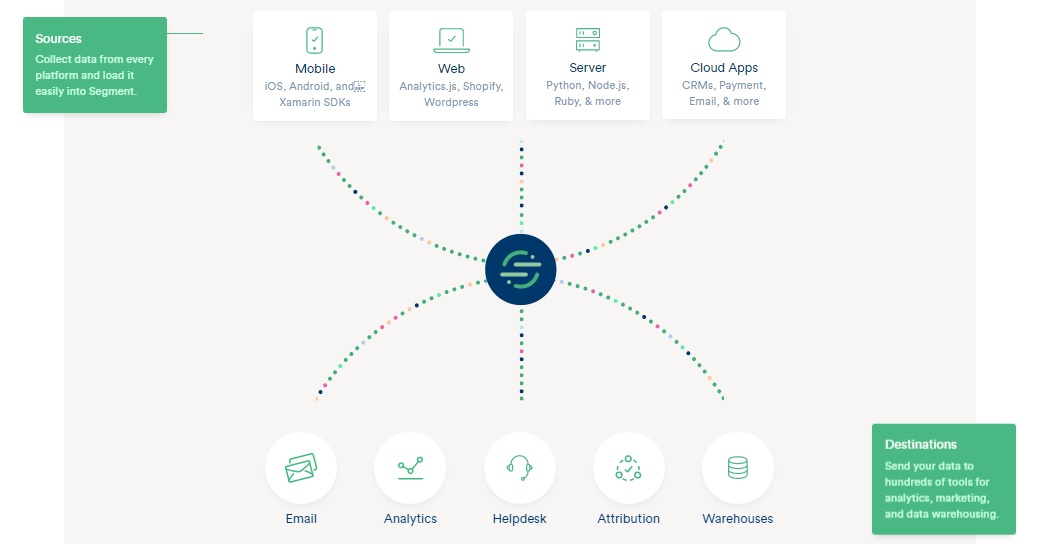
Is lot of your developer time being wasted in managing data collection from your mobile app or website? Has your product slowed down due to several third party integrations? Do you like to experiment with your marketing/analytics stack, trying out new tools and software? If yes, then Segment is the tool for you.
Segment is a powerful and reliable tool that enables organizations collect and aggregate data on their websites or mobile app, and then streams that data to the various analytics and marketing platforms. Segment can collect data from multiple sources, including websites, mobile phones, tablets, servers, point-of-sale registers, and cloud apps. This data can then be relayed to almost every tool imaginable using API calls and webhooks. 180+ API integrations are available. It enables marketing teams to easily integrate and start using new marketing tools without the help of developers, saving development time and avoiding complexities. The probability of third party software bugs also reduces significantly because many third party integrations are no longer required.

Data Sources
The sources from which Segment can collect data are website, mobile, server and cloud apps. In addition to this, data can be imported manually. Lets go through each sources in detail.
Website-
Segment provides an Analytics.js library that can be integrated with any website to collect customer data. This data is stored with segment and can be streamed as required to various marketing or analytics tools and data warehouses.
Mobile-
Segment comes loaded with multiple SDKs to facilitate data collection from mobile apps. Available SDKs are
- Ios SDK
- Android SDK
- Android Wear SDK
- Xamarin SDK
- AMP
Server-
Server level tracking is not recommended unless client side tracking doesn’t works for you. However, if you need it, various server side sources are provided by Segment, namely
- Clojure
- Go
- Java
- js
- PHP
- Python
- Ruby
- .NET
Cloud App-
Cloud App sources will allow you to collect data from your third party cloud based tool. This data however can’t be exported to other third party tools. The integration helps in consolidating data from various tools into your data warehouse. Segment has an inbuilt data warehouse. Various sources from which data can be fetched are
- Salesforce
- Stripe
- Zendesk
- Facebook Ads
- Adwords
- SendGrid
- Mailchimp
- Mandrill
- Twilio
- HubSpot
- Intercom
- Activecampaign
- io
- Drip
- Iterable
- Klaviyo
- Mailjet
- Nudgespot
- Vero
Destinations
Segment facilitates 180+ integrations with various analytics and marketing tools using API. One of the most important USP of segment is the large number of integrations available making it compatible with almost all leading tools around. Some of the most popular integrations are listed below sorted by category.
| A/B Testing | Optimizely, Apptimize, Evergage, Leanplum |
| Advertising | AdRoll, Adwords, Doubleclick, Bing ads, Facebook Pixel, Mediamath |
| Analytics | Google Analytics, Mixpanel, Localytics, Amazon S3, Adobe Analytics, Flurry |
| CRM | Salesforce, Freshsales, Responsys |
| Customer Success | Intercom, Slack, Drift, Relay, Zopium |
| Salesforce Pardot, Oracle Eloqua, Hubspot, Marketo, Mailchimp, Customer.io | |
| Heatmaps | FullStory, Lucky Orange, Crazy Egg, Mouseflow |
| Helpdesk | Zendesk, Help Scout, Elevio, UserVoice |
| Livechat | SnapEngage, Userlike, Livechat, Olark |
| Personalisation | Boomtrain, Hull.io, Appcues, Chameleon, Tray.io, Spinnakr |
| Push Notifications | Webengage, Appboy, CleverTap, Kahuna, Urban Airship |
| Raw Data | Iron.io, Treasure Data, Webhooks |
| SQL | JackDB, Xplenty, Periscope.io |
| Security | Smyte, Castle |
| Surveys | Promoter.io, Wootric, Qualaroo, SatisMeter |
| Tag Managers | Google Tag Manager |
Features
Segment basically helps businesses to gather large amounts of data reliably from online platforms across multiple touch points and relay it to their analytics and marketing integrations. Instead of integrating all these tools separately, Segment’s javascript client is integrated just once with their platforms saving lots of developer time, hard work, complexities and providing a unified structure to their data. Segment is highly scalable and can cater to even millions of daily visitors. Major USPs of Segment can be listed as under
- Segment is highly scalable.
- Open source SDKs help developers better understand the data flow enabling easy one time integration.
- An inbuilt debugger helps solve integration issues with ease.
- Segment is highly reliable. Thanks to its fault tolerant libraries.
- Segment stores raw data that can be used later
- Storage of raw data also enables relay of historical data to any new tool that has been integrated.
- Segment has inbuilt self-hosted data warehousing capabilities.
- Has been optimized for mobile devices making it a favorite for use with Android/Ios apps.
Pros
- One integration enables streaming of data pretty much anywhere you want. It keeps the code uncluttered and helps developers focus on building features.
- Instead of littering the code with numerous JavaScript libraries and dealing with maintenance and loading issues, you can consolidate it into calls from one JavaScript library that does what is specifically required.
- Lot of precious developer time is saved, simultaneously empowering marketing teams to easily add new tools in the marketing technology stack allowing them to focus on marketing efforts. This gives marketers flexibility in use of new tools.
- Customer support provided by Segment team is remarkably awesome.
- Easy to use UI along with a powerful debugger makes Segment very user friendly.
- Fair pricing.
Cons
- Most integrations don’t let you decide what events to relay. You will have to code the filters in the app instead of using segment to achieve this.
- Using Segment might sometimes inhibit you from leveraging advanced integration features from third party software that otherwise you could have used.
Pricing
A free plan is available, limited to 1000 Monthly Trackable Users. The paid plan starts from 100 USD. It’s a pay as you scale based plan costing USD 10 for every 1000 MTUs. For bigger businesses, a custom plan is available with custom pricing and lots of additional features and support.
Go for it if
- You use multiple tools that needs to be integrated with your platform.
- You keep experimenting with different third party tools and don’t want to waste time and effort in integrations.
Don’t go for it if
- You use only 2,3 integrations and don’t plan to change them any time soon.
- You need absolute freedom with data being passed or are using a tool that requires some data that cannot be passed using Segment.
Verdict
Segment is a very popular tool with no real competition in its space. It’s a very reliable, scalable and useful product. If Segment fits your requirements based on the above mentioned points, you definitely should try it out.
